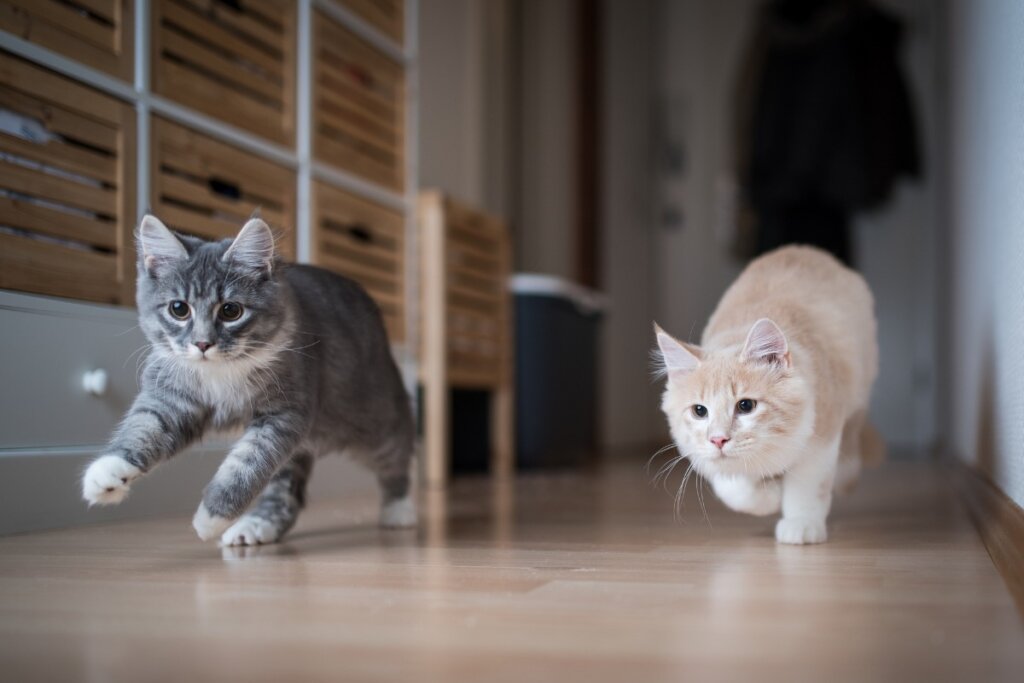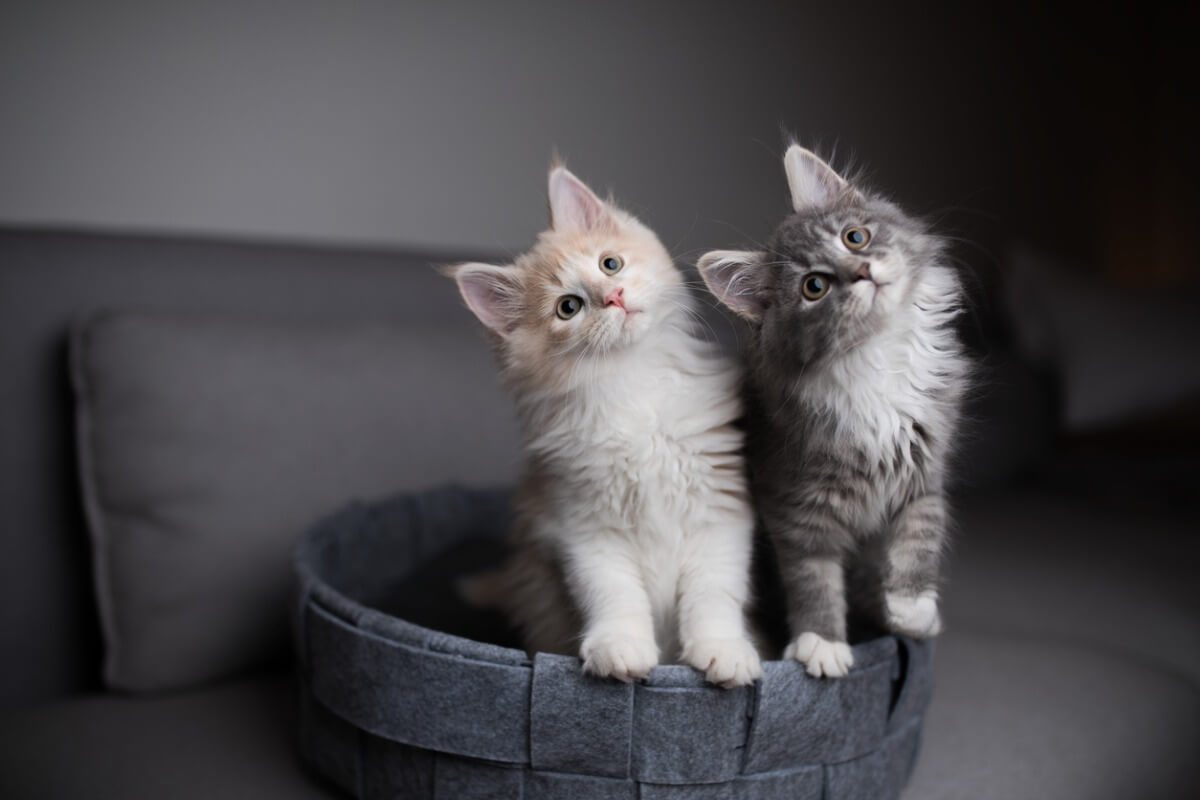How to Help a Cat Accept Another Cat

For many families it’s inevitable: after adopting one cat, you then want another one. However, if you don’t carry out a good process of adaptation when introducing the cats, it can be very difficult to help a cat accept another one that has just arrived.
For this reason, and to avoid more serious problems such as aggression, in this article we bring you everything you need to know before you return to the shelter to adopt a new cat for your family.
How to choose a second cat
The first thing that comes to mind when you think of adopting a second cat is that it should be of the same age and size as the previous one. However, there are other important factors to take into account, among which we highlight the following:
- Activity level: If you live with a cat with quiet habits and low activity levels, then adopting a kitten or an energetic and playful adult cat can be a source of stress for the first one.
- Socialization: If either of the two felines has a problem communicating or living with other cats, problems such as aggression or fear may appear.
- Special needs: One of the cats needing medicinal food can be a source of conflict between the two felines. Although many of these particularities can usually be corrected as they live together, it’s important to take them into account when choosing.
- Diseases: Some ailments can be aggravated by the presence of other felines. For example, an elderly cat with osteoarthritis may suffer an injury at the hands of a kitten who plays carelessly. Other diseases, such as feline immunodeficiency virus (FIV), require a great deal of cohabitation control to avoid contagion.
In any case, when you go to the shelter they’ll help you find the most suitable cat for your particular situation. Keep in mind that they’re looking for the best possible life for their animals, so their priority will be that the cat will find the most appropriate home for their needs.

Introducing a new cat to your home
Before introducing the two cats, the new feline must acclimatize to their new space and perform a type of quarantine to avoid contagion of possible diseases between the two cats. Therefore, at first, the newcomer cat should stay in a closed room, where they’ll gradually get used to their litter box, food, and bed.
To help make things more bearable for the cat, you have the option of using synthetic pheromones, always under the recommendation of the veterinarian. You should also spend time with the cat, so that they can get used to your presence and get to know you thoroughly.
At this point, we recommend that you start the same routine you had with your first cat. In this way, when they begin to live together there will be very few changes for both of them. Cats often suffer stress when their daily lives are altered.
Proper presentation for a cat to accept another
Once the quarantine period is over, it’s time to start with the introductions. In order not to do this in an abrupt and invasive way, there’s a standardized method that’s usually quite effective:
- At first, leave the animals in separate rooms and introduce objects with each other’s scent in order for them to familiarize themselves with the smell of the other.
- After that, allow the cats to sniff each other under the door or see each other through a window. In that way, they’ll be able to get closer without touching each other and identifying each other by smell. Reward them whenever they react non-aggressively towards the other cat.
- Prepare the official presentation: Prepare the area of the introduction with shelters in case one of the two cats needs to hide. Cut their nails, and use an area that’s neutral for both of them, etcetera.
- Let them share the area: Finally, you can let both cats share the common areas. The first few days, this should always be under supervision in order to avoid conflicts. If conflicts occur, go back to the previous step.
Each step of the introduction should be accompanied by positive reinforcement for good behavior and lots of patience. Don’t continue in the process until both felines have stopped showing signs of rejection of their new companion.
The ideal number of beds and feeders should be the number of cats plus one: if you have two cats and three feeders, they won’t have to fight over food.
Why doesn’t the cat accept the new feline?
Cats are solitary and territorial animals by nature. If they’re able to coexist with humans and other animals, it’s thanks to the process of domestication that they’ve undergone. In general, they prefer to have their own space and socialize only when they want to.
In addition, felines are also strongly routine. For the most sensitive ones, a small change in their environment can be a source of constant stress.
Therefore, the most common reasons for a cat not accepting another are usually these: that the first cat has to change their habits, share their resources, and tolerate a cat that wants their attention when they don’t feel like it. Some of the signs of this disagreement are the following:
- The veteran cat grunts at the newcomer: This doesn’t mean things are going to escalate, but you should keep an eye out for a conflict.
- The first feline will paw at the newcomer or block access to resources such as food, litter, or beds.
- Signs of stress: Some cats, instead of defending their territory, suffer from stress that can lead to them hiding, stopping eating, excessive grooming, or avoiding contact with humans.
- Serious aggression: Apart from the odd scratch or a grunt, sometimes the coexistence between two cats can become dangerous. The warning signs become much more intense and there may even be fights between them. If this happens, the two cats should be separated immediately.
Even having made a gradual and calm introduction, the acceptance of one cat towards the other may require some additional time of coexistence. Although complications can occur at these times, it’s almost always possible to get them back on track, so don’t despair.
How long does it take for them to accept each other?
There’s no universal period of time for a cat to accept another cat. Each process will depend on the characteristics of each cat and your efforts to create a positive atmosphere between them.
However, beware of trying to force them to get along, because you could cause just the opposite. They may feel pressured and end up not tolerating each other.
Tips to get a cat to accept another cat
In conclusion, even if your cat accepts another cat that has just arrived, you should always work so that their coexistence is healthy and happy for both. To achieve this, here are some tips:
- Avoid punishments: If you add a new source of discomfort to a stressful situation, you’ll only aggravate the problem and create a negative relationship between the two cats. Always use positive reinforcement to reward good behavior.
- Use synthetic pheromones whenever recommended by your vet.
- Neuter your cats: In addition to avoiding health problems such as cancer and pyometra, neutering reduces the intensity of territorial marking behavior and aggression.

Finally, remember that going to a professional animal behaviorist is always the best option for behavioral problems, especially those that involve aggression. Don’t wait until there’s a fight between the two cats, as they can get seriously injured, and then it’ll be much more difficult to get them to live together peacefully.
All cited sources were thoroughly reviewed by our team to ensure their quality, reliability, currency, and validity. The bibliography of this article was considered reliable and of academic or scientific accuracy.
- DePorter, T. L., Bledsoe, D. L., Beck, A., & Ollivier, E. (2019). Evaluation of the efficacy of an appeasing pheromone diffuser product vs placebo for management of feline aggression in multi-cat households: a pilot study. Journal of feline medicine and surgery, 21(4), 293-305.
- Hart, B., & Barrett, R. E. (1973). Effects of castration on fighting, roaming, and urine spraying in adult male cats. Journal of the American Veterinary Medical Association, 163(3), 290-292.
- Desmontando el mito de la inmunodeficiencia felina: convivir no significa contagiarse. (s. f.). Fundación FAADA. Recuperado 10 de octubre de 2021, de https://faada.org/concienciacion-648-desmontando-el-mito-de-la-inmunodeficiencia-felina-convivir-no-significa-contagiarse
- Bringing a New Cat Home: Preventing Problems. (s. f.). Best Friends Animal Society. Recuperado 10 de octubre de 2021, de https://resources.bestfriends.org/article/bringing-new-cat-home-preventing-problems